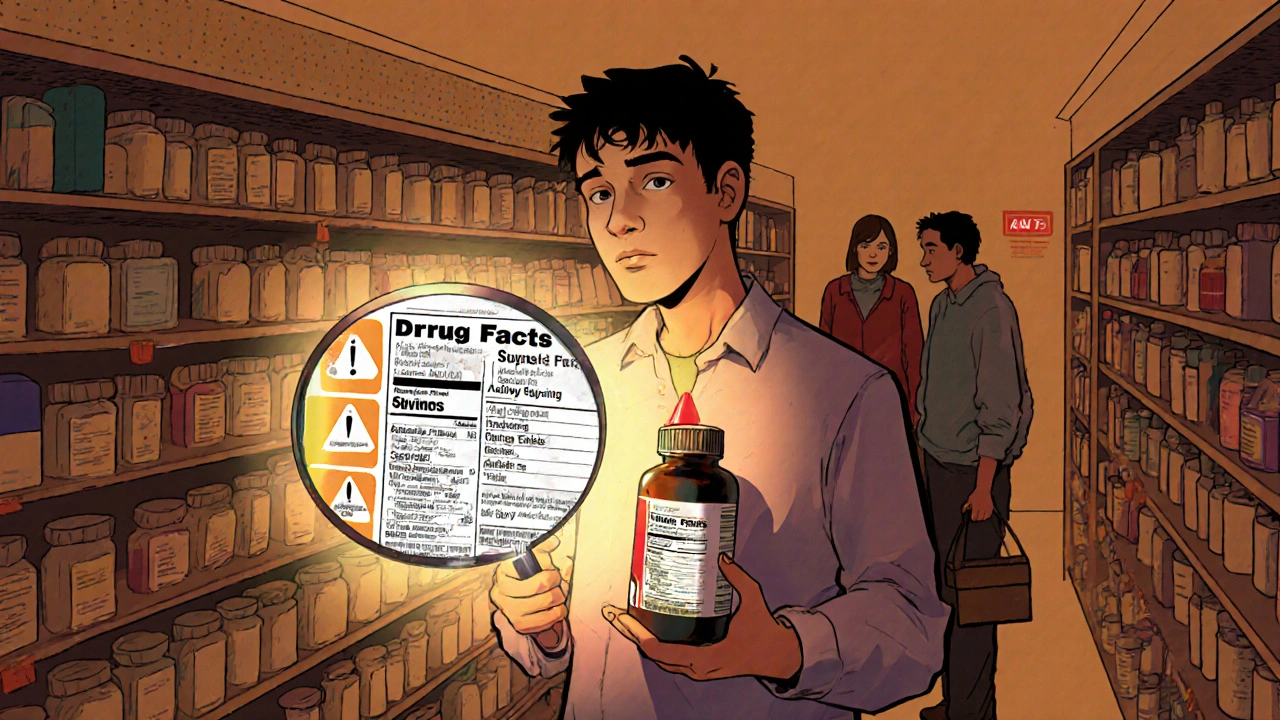Every time you grab a bottle of pain reliever, cold medicine, or even hand sanitizer from the shelf, you’re holding a product regulated by the FDA. But most people never actually read the label. That’s a problem. The OTC Drug Facts label isn’t just fine print-it’s your safety guide. It tells you exactly what’s in the medicine, how to use it safely, and when to stop. If you don’t read it, you’re guessing. And guessing with medicine can be dangerous.
What Is the OTC Drug Facts Label?
The OTC Drug Facts label is a standardized format required by the FDA for all over-the-counter medicines sold in the U.S. It was introduced in 1999 to fix a big problem: before this, every brand used its own layout. One bottle might list ingredients at the bottom, another in tiny font on the side. No consistency meant people missed critical info-like taking two medicines with the same active ingredient and overdosing on acetaminophen. Now, every OTC product-whether it’s allergy pills, antacids, cough syrup, or sunscreen-must follow the exact same structure. The FDA made this rule because people were getting hurt. Studies show that before the label was standardized, only 29% of consumers could find the right dosage. After the change, that number jumped to 76%. The label isn’t just helpful-it’s lifesaving.The Eight Sections You Must Read
The Drug Facts label has eight sections, always in the same order. You don’t need to read the whole thing every time, but you should know where to find each piece of info. Here’s what each one means:- Drug Facts - This is the title. If you see it, you’re looking at the official FDA-mandated label.
- Active Ingredient(s) - This is the medicine itself. It’s listed by its generic name, not the brand name. For example, “acetaminophen” instead of “Tylenol.” The amount per dose (like 325 mg) is right next to it. If a product has multiple active ingredients, they’re listed alphabetically. This is the most important section for avoiding double-dosing. If you’re taking two medicines and both list acetaminophen, you’re at risk for liver damage.
- Purpose(s) - This tells you what kind of drug it is. Is it a pain reliever? An antihistamine? A decongestant? This helps you understand how it works and whether it’s right for your symptoms.
- Use(s) - This lists the symptoms or conditions the medicine treats. “Relieves headache,” “reduces fever,” “temporarily relieves runny nose.” If your symptom isn’t listed, don’t use it. That’s not what the medicine is approved for.
- Warnings - This is where things get serious. It tells you when not to use the product. Look for red boxes-that’s where the FDA requires urgent warnings like “Do not use if you have liver disease” or “May cause severe allergic reactions.” Also watch for “Stop and ask a doctor if…” and “Stop using if…” These mean: if you feel this, stop immediately. Don’t wait. These warnings cover drug interactions, allergies, pregnancy, and conditions like asthma or high blood pressure.
- Directions - This tells you exactly how to take it. How many pills? How often? With food or on an empty stomach? For adults? For kids? For seniors? Pay attention to age-based dosing. A child’s dose isn’t just half of an adult’s-it’s calculated by weight and age. And don’t guess with liquid medicines. Use the measuring cup or syringe that came with the bottle. A kitchen spoon is not accurate.
- Other Information - This includes storage tips (like “keep at room temperature”) and sodium content. Yes, even your cold medicine might have salt in it. If you’re on a low-sodium diet, this matters.
- Inactive Ingredients - These are the fillers, dyes, and preservatives. They don’t treat your symptoms, but they can cause reactions. If you’re allergic to red dye #40, soy, or lactose, check here. This section is often ignored, but it’s critical for people with allergies or sensitivities.
Why the Order Matters
The FDA didn’t arrange these sections randomly. They’re ordered by risk and priority. You start with what’s in the medicine, then learn what it does, then find out what could go wrong, and finally how to use it correctly. This order forces you to think about safety before you take action. For example, if you see a warning that says “Do not use if you take blood thinners,” you should stop and check your other meds before even reading the directions. The label is designed to make you pause, not rush.
Common Mistakes People Make
Even with a clear label, people still make the same mistakes over and over:- Taking two medicines with the same active ingredient - This is the #1 cause of accidental overdose. You take a cold medicine with acetaminophen, then take a painkiller with acetaminophen. Boom-overdose. The liver can’t handle it.
- Using a kitchen spoon to measure liquid medicine - A tablespoon is not 15 mL. It’s often more. A teaspoon might be 5 mL, but not always. Always use the measuring tool that came with the bottle.
- Ignoring the “Stop if…” warnings - If the label says “Stop using if you develop a rash,” and you get one, you don’t wait to see if it goes away. You stop. Now.
- Assuming “natural” means safe - Herbal supplements sold as OTC products still have active ingredients. They can interact with prescription drugs. Just because it’s labeled “herbal” doesn’t mean it’s harmless.
- Not checking the expiration date - Expired medicine can lose potency or break down into harmful substances. If it’s past the date, toss it.
What’s Not on the Label
The Drug Facts label doesn’t tell you everything. It won’t explain how the medicine works in your body. It won’t compare brands. It won’t tell you about long-term side effects beyond what’s legally required. That’s why you should still talk to your pharmacist. They can help you connect the dots between your prescriptions, supplements, and OTC meds. Also, the label doesn’t cover everything you might buy as an “OTC product.” Things like dietary supplements, vitamins, and homeopathic remedies are not regulated under the same rules. They don’t have Drug Facts labels. If it doesn’t have a Drug Facts label, it’s not an FDA-regulated medicine.How to Use the Label Like a Pro
Here’s a simple routine you can follow every time you pick up an OTC medicine:- Look for the Drug Facts heading. If it’s not there, don’t buy it.
- Check the Active Ingredient. Is it something you’re already taking? If yes, don’t double up.
- Scan the Warnings. Are you pregnant? Do you have high blood pressure? Is your child under 6? Make sure the warning doesn’t apply to you.
- Read the Directions. Are you giving the right dose for age and weight? Are you using the right measuring tool?
- Check the Inactive Ingredients. Any allergens? Any dyes or fillers you know you react to?
What’s Changing in 2025?
The FDA is testing new ways to make labels even clearer. Some companies are now including QR codes that link to video instructions or multilingual translations. This is especially helpful for older adults or people with limited English. The FDA is also working on better labeling for combination products-like creams that treat both acne and inflammation. But the core Drug Facts format isn’t going away. It’s proven to work. Since 2003, when full compliance kicked in, medication errors involving OTC drugs have dropped by 27%. That’s over 300,000 fewer emergency room visits a year.Final Tip: Make It a Habit
You wouldn’t drive a car without reading the manual. Why take a pill without reading the label? The OTC Drug Facts label is your only defense against accidental overdose, dangerous interactions, and misuse. It’s free, it’s right on the package, and it’s designed to keep you safe. Next time you reach for an OTC medicine, pause. Read the label. It’s not just instructions-it’s protection.Do all over-the-counter medicines have a Drug Facts label?
Yes, all OTC medicines regulated by the FDA must have a Drug Facts label. This includes pain relievers, cold and allergy meds, antacids, antifungal creams, sunscreens, and even some toothpastes and hand sanitizers. However, dietary supplements, herbal remedies, and homeopathic products are not required to have this label-they fall under different rules and often lack standardized safety info.
Can I trust the active ingredient list on the label?
Yes. The FDA requires manufacturers to list active ingredients by their official generic names and exact amounts per dose. This information is verified during the product approval process. If a product is sold legally in the U.S., the active ingredient list is accurate. Always use this list to avoid duplicate medications-like taking two different cold medicines that both contain pseudoephedrine.
Why are some warnings in red boxes?
The FDA requires certain high-risk warnings to appear in red boxes to grab attention. These include warnings about liver damage (especially with acetaminophen), severe allergic reactions, asthma risks, and potential for serious side effects in children or elderly users. If you see a red box, it means the risk is serious enough that ignoring it could lead to hospitalization or death.
What should I do if I can’t read the label?
Don’t guess. Ask your pharmacist or doctor. Many pharmacies offer large-print labels or audio instructions. The FDA also has free resources in multiple languages on its website. If you’re helping an older relative, read the label aloud with them. Never assume you know what’s in a medicine just because you’ve used it before-formulas change.
Is it safe to use expired OTC medicine?
It’s not recommended. While most expired OTC medicines don’t become toxic, they can lose effectiveness. For example, an expired epinephrine auto-injector or antihistamine might not work when you need it most. Some medications, like liquid antibiotics or insulin, can break down into harmful substances. When in doubt, dispose of it properly and get a new one.
How do I know if a medicine is right for my child?
Check the Directions section for age-specific dosing. Never give adult medicine to a child unless the label says it’s safe. Many OTC medicines are not approved for children under 6. If the label says “do not use in children under 12,” that’s not a suggestion-it’s a safety rule. Use pediatric formulations and always measure with the provided dosing tool, not a kitchen spoon.
Can I use an OTC medicine with my prescription drugs?
Not without checking. Many OTC medicines interact with prescriptions. For example, ibuprofen can increase bleeding risk if you’re on blood thinners. Antihistamines can worsen glaucoma or urinary retention. Always read the Warnings section for drug interactions, and talk to your pharmacist before combining OTC and prescription meds. They keep a full list of what you’re taking.


